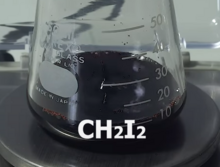Diiodomethane
 | |||
| |||
 | |||
| Names | |||
|---|---|---|---|
| Preferred IUPAC name
Diiodomethane[1] | |||
| Identifiers | |||
3D model (JSmol)
|
|||
| 1696892 | |||
| ChemSpider | |||
| ECHA InfoCard | 100.000.765 | ||
| EC Number |
| ||
| MeSH | methylene+iodide | ||
PubChem CID
|
|||
| RTECS number |
| ||
| UNII | |||
CompTox Dashboard (EPA)
|
|||
| |||
| |||
| Properties | |||
| CH2I2 | |||
| Molar mass | 267.836 g·mol−1 | ||
| Appearance | Colorless liquid | ||
| Density | 3.325 g mL−1 (3325 kg/m3) | ||
| Melting point | 5.4 to 6.2 °C; 41.6 to 43.1 °F; 278.5 to 279.3 K | ||
| Boiling point | 182.1 °C; 359.7 °F; 455.2 K | ||
| 1.24 g L−1 (at 20 °C)[2] | |||
Henry's law
constant (kH) |
23 μmol Pa−1 kg−1 | ||
| -93.10·10−6 cm3/mol | |||
| Structure | |||
| Tetragonal | |||
| Tetrahedron | |||
| Thermochemistry | |||
Heat capacity (C)
|
133.81 J K−1 mol−1 | ||
Std enthalpy of
formation (ΔfH⦵298) |
67.7–69.3 kJ mol−1 | ||
Std enthalpy of
combustion (ΔcH⦵298) |
−748.4–−747.2 kJ mol−1 | ||
| Hazards | |||
| GHS labelling: | |||
 
| |||
| Danger | |||
| H302, H315, H318, H335 | |||
| P261, P280, P305+P351+P338 | |||
| NFPA 704 (fire diamond) | |||
| Flash point | 110 °C (230 °F; 383 K) | ||
| Safety data sheet (SDS) | hazard.com | ||
| Related compounds | |||
Related alkanes/haloalkanes
|
|||
Except where otherwise noted, data are given for materials in their standard state (at 25 °C [77 °F], 100 kPa).
| |||
Diiodomethane or methylene iodide, commonly abbreviated "MI", is an organoiodine compound. Diiodomethane is a very dense colorless liquid; however, it decomposes upon exposure to light liberating iodine, which colours samples brownish. It is slightly soluble in water, but soluble in organic solvents. It has a very high refractive index of 1.741, and a surface tension of 0.0508 N·m−1.[3]
Uses
[edit]Because of its high density, diiodomethane is used in the determination of the density of mineral and other solid samples. It can also be used as an optical contact liquid, in conjunction with the gemmological refractometer, for determining the refractive index of certain gemstones.
Diiodomethane is a reagent for installing the CH2 group. In the Simmons–Smith reaction, it is a source of methylene.[4] In fact the Simmons–Smith reaction does not produce free carbene but proceeds via Zn-CH2I intermediates.
Diiodomethane is also a source of the equivalent of CH2+2. The synthesis of Fe2(CH2)(CO)8 illustrates this reactivity:[5]
- Na2Fe2(CO)8 + CH2I2 → Fe2(CH2)(CO)8 + 2 NaI
Preparation
[edit]Diiodomethane can be prepared from the widely available solvent dichloromethane by the action of sodium iodide in acetone in the Finkelstein reaction:[6]
- CH2Cl2 + 2 NaI → CH2I2 + 2 NaCl
It can also be prepared by reducing iodoform with elemental phosphorus[7] or sodium arsenite:[6]
- CHI3 + Na3AsO3 + NaOH → CH2I2 + NaI + Na3AsO4
Safety
[edit]Alkyl iodides are alkylating agents, which are potential mutagens.
References
[edit]- ^ "methylene iodide - Compound Summary". PubChem Compound. USA: National Center for Biotechnology Information. 26 March 2005. Identification ad Related Records. Retrieved 27 February 2012.
- ^ "Diiodomethane".
- ^ Website of Krüss Archived 2013-12-01 at the Wayback Machine (8.10.2009)
- ^ Two cyclopropanation reactions: Smith, R. D.; Simmons, H. E. "Norcarane". Organic Syntheses; Collected Volumes, vol. 5, p. 855., Ito, Y.; Fujii, S.; Nakatuska, M.; Kawamoto, F.; Saegusa, T. (1988). "One-Carbon Ring Expansion Of Cycloalkanones To Conjugated Cycloalkenones: 2-Cyclohepten-1-one". Organic Syntheses; Collected Volumes, vol. 6, p. 327.
- ^ Sumner, Charles E.; Riley, Paul E.; Davis, Raymond E.; Pettit, R. (1980). "Synthesis, Crystal Structure, and Chemical Reactivity of Octacarbonyl-μ-methylene-diiron". Journal of the American Chemical Society. 102 (5): 1752–1754. doi:10.1021/ja00525a062.
- ^ a b Roger Adams; C. S. Marvel (1921). "Methylene Iodide". Organic Syntheses. 1: 57. doi:10.15227/orgsyn.001.0057.
- ^ Miller, William Allen (1880). Elements of Chemistry: Chemistry of carbon compounds (5th ed.). London: Longmans Green and Co. p. 154.



